Namur Belgian-American District | |
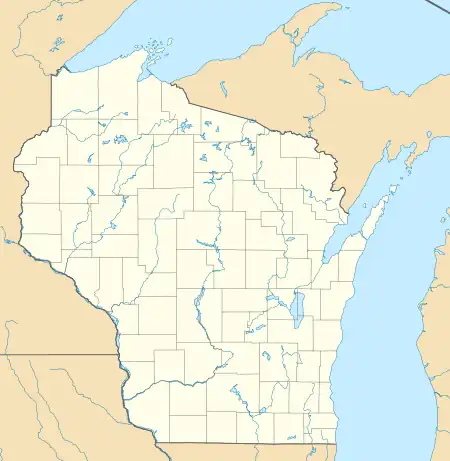  | |
| Location | Namur, Wisconsin |
|---|---|
| Coordinates | 44°44′3″N 87°39′59″W / 44.73417°N 87.66639°W |
| Area | 3,500 acres (1,400 ha) |
| Architect | Varies |
| NRHP reference No. | 87002553 |
| Significant dates | |
| Added to NRHP | November 6, 1989[1] |
| Designated NHLD | December 14, 1990[2] |
The Namur Historic District, also known as the Namur Belgian-American District, is a historic district in southwestern Door County, Wisconsin.[3] The district includes the community of Namur and a rural landscape extending 3 miles (4.8 km) to its north. It contains one of the nation's highest concentrations of immigrant Belgian and Belgian-American culture, land use, and architecture. It was declared a National Historic Landmark in 1990.[2]
Description and history
In the 1850s, in response to a drive by the state of Wisconsin to increase settlement of its rural areas, immigrants from Belgium began to arrive in the state. Originating in the provinces of Namur and Brabant, they settled on the eastern shore areas of Brown, Kewaunee, and Door counties. They used indigenous materials in combination with traditional building practices imported from their homeland to construct an architecturally distinct landscape. Houses were typically built out of either red brick or limestone, with frame outbuildings. In the 1860 and 1870 censuses Wisconsin had a higher percentage of Belgian-origin residents than any other state. The area around the village of Namur was judged in a wide-ranging survey of Belgian-settled areas to best represent this influx.[4]
The historic district is basically rectangular in shape, with the village of Namur just north of its southern boundary. To the west and north, it is bordered by Green Bay and County Road "K", and to the east it is bordered by the properties on Thruway Road. Covering about 3,500 acres (1,400 ha), the district includes over 180 historically significant buildings, most of them farm-related buildings. There are 41 separate farmsteads, each averaging more than five buildings. Properties were typically developed between 1880 and 1930. Non-residential properties include the St. Mary's Catholic Church and parsonage house in Namur, and the Harold Euclide General Store, built in 1916.[4]
Gallery
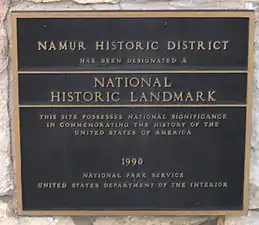 Historical Plaque Near Namur
Historical Plaque Near Namur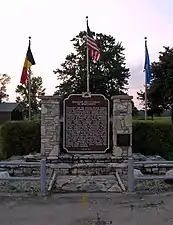 Historical Marker Near Namur
Historical Marker Near Namur Our Lady of the Snows church
Our Lady of the Snows church Brick house and log shed
Brick house and log shed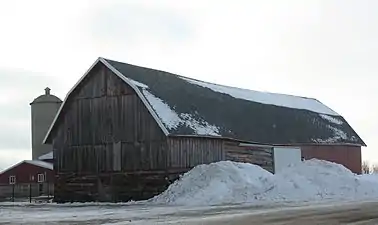 Log barn
Log barn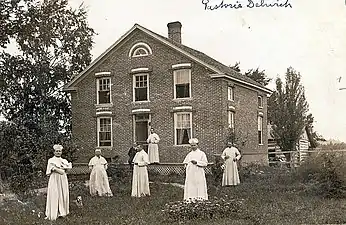 School run by the St. Norbert Abbey c. 1897; a marker honoring the location of this school at the historic district claims it as the birthplace of the Norbertine Fathers[5] St. Norbert Abbey today is located in De Pere.
School run by the St. Norbert Abbey c. 1897; a marker honoring the location of this school at the historic district claims it as the birthplace of the Norbertine Fathers[5] St. Norbert Abbey today is located in De Pere.
See also
References
- ↑ "National Register Information System". National Register of Historic Places. National Park Service. January 23, 2007.
- 1 2 "Namur Historic District". National Historic Landmark summary listing. National Park Service. Archived from the original on April 3, 2009. Retrieved January 3, 2008.
- ↑ Roughly bounded by CTH K, Brussels Rd., STH 57, Belgian Dr., and the Green Bay Rd., Wisconsin Historical Society, 2021
- 1 2 "NHL nomination for Namur Historic District". National Park Service. Retrieved March 24, 2017.
- ↑ Birthplace of Norbertine Fathers. wisconsinhistoricalmarkers.com, 2017
External links
- Namur Historic District, Wisconsin Historical Society
- Former St. Mary of the Snows Schoolhouse/Convent, history presentation, Door County Library, May 10, 2021, 45:09 long